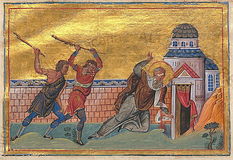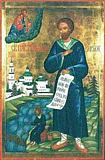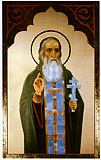

| Previous day | Next day |
| Old Style
September 12
|
Wednesday |
New Style
September 25
|
|
15th Week after Pentecost.
Tone 5.
Fast Day. |
Wine and oil allowed.
|
![]() Apodosis of the Nativity of the Theotokos.
Apodosis of the Nativity of the Theotokos. ![]() Hieromartyr Autonomus, bishop, in Italy (313). St. Athanasius, disciple of St. Sergius of Radonezh and first abbot of the Vysotsk Monastery in Serpukhov, and his disciple St. Athanasius (1395).
Hieromartyr Autonomus, bishop, in Italy (313). St. Athanasius, disciple of St. Sergius of Radonezh and first abbot of the Vysotsk Monastery in Serpukhov, and his disciple St. Athanasius (1395).
St. Coronatus, bishop of Nicomedia (Iconium) (249-259). Martyr Julian of Galatia, and 40 martyrs with him (4th c.). St. Bassian of Tiksna (Vologda) (1624-1633). Translation of the relics of Righteous Symeon of Verkhoturye (1704). Martyr Theodore of Alexandria. Hieromartyr Dositheus, metropolitan of Tbilisi, Georgia (1795).
New Martyr Alexis, fool-for-Christ, of Elnat and Zharki, near Kineshma (1937).
Martyrs Macedonius, Tatian, and Theodulus, in Phrygia (4th c.). St. Ailbhe (Elvis) of Emly (527). St. Sacerdos, bishop of Lyons (551). St. Molaise of Devenish (563). St. Eanswythe, abbess, of Folkestone (ca. 640). St. Daniel, monk, of the island of Thasos (ca. 843). St. Andronicus of Atroa (9th c.).
Thoughts for Each Day of the Year
According to the Daily Church Readings from the Word of God
By St. Theophan the Recluse

Thursday. [Gal. 3:23-4:5; Mark 6:30-45]
And people ran afoot thither out of all cities…and came together unto Him. This is to the Bethsaida desert, where the marvellous filling of five thousand with five loaves of bread and two fishes was performed. What drew the people to the Lord? Sympathy towards the Divine. The Divinity of the Lord, hidden under the cover of human nature, revealed itself in word, deed, gaze, and in all that was visible in the Lord. The manifestations of the Godhead awakened a feeling of the Godhead hidden in the heart, and through it drew people to the Lord. Nobody has power to hold back such a movement toward the Lord, not even the one who feels it, because it is deeper and stronger than all other movements. The same Divinity, manifested later by the Saviour, drew people of every tongue under the heavens to Him. It has been the same throughout the entire history of the Church, even to this day. A small trace of the Divine draws people to itself. What follows from this experience everywhere and at all times of our spirit’s aspiration for the Divine? What follows is that what is Divine, what is supernatural—is the Godhead, its source. This aspiration lies in the foundation of our spirit and constitutes its nature, as anyone can see from our intellectual, aesthetic and practical concerns. But in nature there cannot be lies and deception; consequently they do not exist in this aspiration for the Godhead. From this it follows that God and the Divine exist, and that the naturalists, in rejecting what is supernatural, are going against the nature of the human spirit.
Articles
 Hieromartyr Autonomus the Bishop in ItalyThe Hieromartyr Autonomus was a bishop in Italy. |




